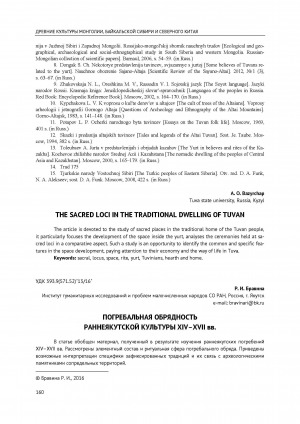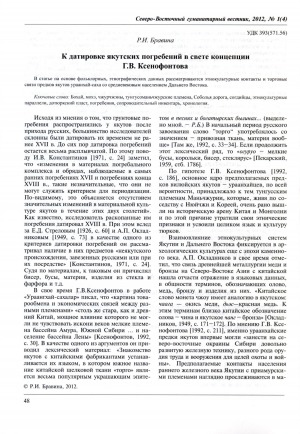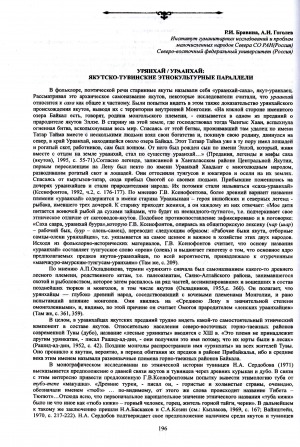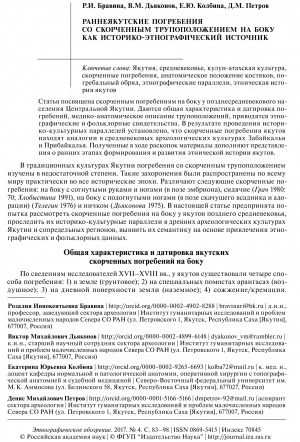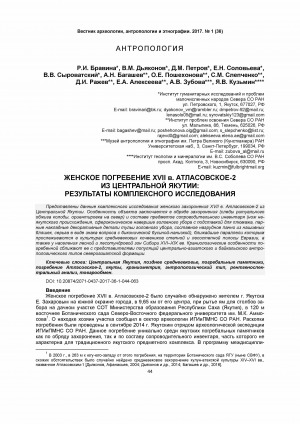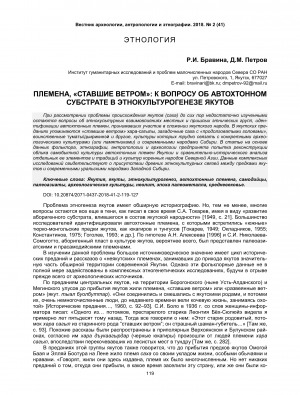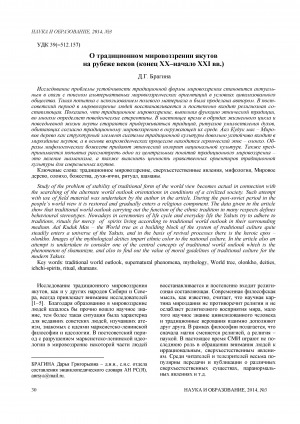Количество страниц: 6 с.
This paper aims to reconstruct the funeral rites of the early Yakut culture before arrival of Russians. It is based on the analysis of the burial composition and the ritual sphere of the funerary monuments of XIV–XVII centuries. The distinguishing feature of the burial composition of this time is a small depth of the burial pit, which on average is 0,48 cm deep. Box coffins are more common, and their parameters and structure are similar to those of the Hun coffins, with a similar external camera - grobovina, a special section for grave goods, and a lengthwise dividing wall in joint burials. The western orientation of the dead is associated with the traditional worldview about the geography of the world of the dead. The dead were buried horizontally lying on their back or in a crouched position lying on their side, sometimes with the head of the deceased resting on the saddle. The accompanying grave goods consist of household items, horse equipment, weapons and hunting tools, clothing and jewellery, as well as food for the journey in the form of lumps of a young horse. In At Dabaan III burial, there was discovered a pit with a dismembered horse next to the burial of the boy. The early Yakut burials are genetically related to the whole layer of ancient and medieval cultures of the Eurasian steppes in many respects. Their origin can be traced in archaeological complexes of Central Asia, Siberia and the Far East, where the funeral traditions of the medieval tribes of Baikal region and the Amur region are their nearest equivalents.
Бравина, Р. И. Погребальная обрядность раннеякутской культуры XIV-XVII вв.=Funeral rites of early Yakut culture of XVI–XVII centuries / Р. И. Бравина // Древние культуры Монголии, Байкальской Сибири и Северного Китая : материалы VII международной научной конференции, Красноярск, 3-7 октября 2016 г. — Красноярск : Сибирский федеральный университет, 2016. — Т. 2. — С. 160-165.
Количество страниц: 6 с.
- Общественные науки. Образование > Этнография. Обычаи. Жизнь народа. Нравы,
- Краеведение. Археология. География. Биографии. История > Историческая наука. Историография > Археология,
- НАУКА ЯКУТИИ > ОБЩЕСТВЕННЫЕ НАУКИ > Этнография. Обычаи. Жизнь народа. Нравы,
- НАУКА ЯКУТИИ > КРАЕВЕДЕНИЕ. ГЕОГРАФИЯ. БИОГРАФИИ. ИСТОРИЯ > Историческая наука. Историография > Археология.
Бравина, Р. И. К датировке якутских погребений в свете концепции Г. В. Ксенофонтова=On the dating of Yakut burials in the light of G. V. Ksenofontov's conception / Р. И. Бравина // Северо-Восточный гуманитарный вестник. – 2012. – N 1 (4). – С. 48-53.
Количество страниц: 4 с.
Бравина, Р. И. Урянхай / Ураанхай : якутско-тувинские этнокультурные параллели / Р. И. Бравина, А. И. Гоголев // Материалы V международной научной конференции "Древние культуры Монголии и Байкальской Сибири" (Кызыл, 15-19 сентября 2014 года). — Кызыл : Тувинский государственный университет, 2014. — Ч. 1. — С. 196-199.
Количество страниц: 12 с.
К вопросу о ритуально потревоженных захоронениях якутов (XVII–ХVIII вв.) / Р. И. Бравина, В. М. Дьяконов, Е. Ю. Колбина, Д. М. Петров // Вестник археологии, антропологии и этнографии. – 2016. – N 2 (33). – С. 86-96.
DOI: 10.20874/2071-0437-2016-33-2-086-096
Количество страниц: 16 с.
The article examines burials in a flexed position among the Late Middle Age population of Central Yakutia. We provide information on the general features and dating of the burials, medical and anatomical descriptions of the corpse placement, as well as available ethnographic and folklore evidences. The comparison of various historical and cultural parallels makes it possible to argue that in the Middle Age archaeological cultures of the Baikal area, there are burials that are analogous to the flexed position burials of the Yakut. The data obtained as a result of this research make important contributions to our knowledge of the early ethnic history of the Yakut.
Раннеякутские погребения со скорченным трупоположением на боку как историко-этнографический источник / Р. И. Бравина, В. М. Дьяконов, Е. Ю. Колбина, Д. М. Петров // Этнографическое обозрение. — 2017. — N 4, июль-август. — С. 83-98.
Количество страниц: 20 с.
Комплексное исследование раннеякутского сергеляхского погребения середины XV — начала XVI в. / Р. И. Бравина, В. М. Дьяконов, Е. Н. Николаев [и др.] // Вестник археологии, антропологии и этнографии. – 2016. – N 4 (35). – С. 90-109.
DOI: 10.20874/2071-0437-2016-35-4-090-109
Количество страниц: 20 с.
Женское погребение XVII в. Атласовское-2 из центральной Якутии: результаты комплексного исследования / Р. И. Бравина, В. М. Дьяконов, Д. М. Петров [и др.] // Вестник археологии, антропологии и этнографии. – 2017. – N 1 (36). – С. 44-63.
DOI: 10.20874/2071-0437-2017-36-1-044-063
Количество страниц: 10 с.
The study of the origin of the Yakuts focuses on the ethnic history of their alien Turkic-Mongolian ancestors. Issues of mutual ethnocultural influence of local and alien ethnic groups and identification of autochthonous tribes who took part in formation of the Yakut people are not fully researched. Yakut legends mention the tribes Һwhich became windһ, Khara-Sagyly, the mysterious Һlong-headedһ Sakha, the bellicose Tumats/Jirikinei, etc. The question of their ethnic identification is one of the most complex and not fully developed within the issue of ethnocultural genesis of the Yakuts. Some researchers (A.P. Okladnikov, S.I. Tokarev, I.V. Konstantinov, I.E. Zykov and A.I. Gogolev) consider these autochthonous tribes as the Tungusic peoples. According to a hypothesis by A.N. Alekseev and S.I. Nikolaev-Somogotto, an aboriginal layer in the Yakut culture was probably represented by paleo-Siberian and pre-Samoyedic tribes. A successful study of this issue was largely impeded by the lack of informative and sufficiently reliable sources. This problem has been partly solved due to new archaeological discoveries in the last decade, especially to that of a multi-layered man site in Ulakhan Segelenneekh on the Olekma river and thanks to the data of modern molecular-genetic researches. An attempt of a paleoethnic reconstruction of the original culture of the autochthonous tribes of Yakutia and of a comparative historical analysis of ancient traditions and cultures of indigenous peoples of Northern Asia was made in the article combining the data on folklore, toponymics, ethnography, archaeology and ethnic genetics. Integrated research data tell about the presence of ancient ethnocultural links between ancestors of the Yakuts and modern Ural peoples of Western Siberia. The tribes from historical lore and Yakutian legends are said to be aboriginal population of the north-western border of Yakutia, successors of the local archaeological cultures of the Late Neolithic and the Paleometal Age. The material given describes ethnocultural complex processes that took place in ancient Yakutia, which contributed to the formation of the Yakut ethnos and its culture
Бравина, Р. И. Племена, "ставшие ветром": к вопросу об автохтонном субстрате в этнокультурогенезе якутов / Р. И. Бравина, Д. М. Петров // Вестник археологии, антропологии и этнографии. – 2018. – N 2 (41). – С. 119-127.
DOI: 10.20874/2071-0437-2018-41-2-119-127
Количество страниц: 14 с.
Береста в погребальном обряде якутов: по материалам погребения Учугей Юрях (XV–XVII вв.) / Р. И. Бравина, Е. Н. Соловьева, Д. М. Петров, В. В. Сыроватский // Вестник археологии, антропологии и этнографии. – 2021. – N 3 (54). – С. 95-106. — DOI: 10.20874/2071-0437-2021-54-3-8.
DOI: 10.20874/2071-0437-2021-54-3-8
Количество страниц: 6 с.
Брагина, Д. Г. О традиционном мировоззрении якутов на рубеже веков (конец XX - начало XXI вв.) / Д. Г. Брагина // Наука и образование. – 2014. – N 3 (75). – С. 30-35.
